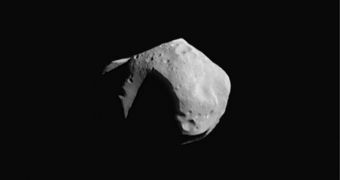Currently, asteroid deflection technologies are quasi-inexistent. Astronomers are painfully aware of that, so there is an ongoing effort to create some means of defending our planet, were it to come under threat. Researchers in Glasgow are now developing a technique for doing just that.
University of Strathclyde engineers want to use solar-powered lasers, mounted on a constellation of small, inexpensive satellites, to alter the path of asteroids that may be on an impact course with Earth.
The spacecraft would fly in formation, and fire their lasers in a complementary manner. A single satellite would have little effect of a large space rock, but a swarm of them could theoretically make a significant difference.
At this point, most deflection technologies rely on the use of very large satellites, which are difficult to maneuver in space, and require a lot of fuel and other resources to operate. The new approach would eliminate many of these inconveniences.
The laser-based technique is developed by a team led by Strathclyde Department of Mechanical and Aerospace Engineering expert Massimiliano Vasile. He says that instances such as the Tunguska explosion, which razed thousands of square kilometers of Siberian forest in 1911, could happen again.
The impact believed to have caused the disaster was produced by an asteroid just 30 to 50 meters (98.4 to 164 feet) across. A larger space rock would have done significantly more damage, perhaps even cause an extinction event, Astrobiology Magazine reports.
“The approach we are developing would involve sending small satellites, capable of flying in formation with the asteroid and firing their lasers targeting the asteroid at close range,” Vasile explains.
“The use of high power lasers in space for civil and commercial applications is in its infancy and one of the main challenges is to have high power, high efficiency and high beam quality all at the same time,” the investigator goes on to say.
He adds that one of the main problems an asteroid-deflecting satellite constellation may have is contamination. As the lasers hit the surface of a space rock, the resulting plumes of vapors could interfere with the light beams, rendering them ineffective.
The researchers caught a break when they determined that the amount of contamination they could expect to measure was a lot smaller than originally predicted. At the same time, their lasers proved able to continue operating for longer periods of time than anticipated.
“The Tunguska class of events are expected to occur within a period of a few centuries. Smaller asteroids collide with Earth more frequently and generally burn in the atmosphere although some of them reach the ground or explode at low altitude potentially causing damage to buildings and people,” Vasile concludes.

 14 DAY TRIAL //
14 DAY TRIAL //